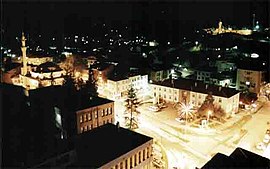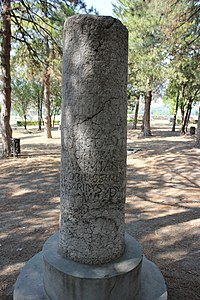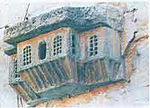Zile
Zile | |
|---|---|
 Zile City Center at night | |
| Coordinates: 40°18′N 35°53′E / 40.300°N 35.883°E | |
| Country | Turkey |
| Province | Tokat |
| District | Zile |
| Government | |
| • Mayor | Şükrü Sargın (CHP) |
| Elevation | 710 m (2,330 ft) |
| Population (2022)[1] | 33,557 |
| Time zone | UTC+3 (TRT) |
| Postal code | 60400 |
| Area code | 0356 |
| Website | www |
Zile, anciently known as Zela (
History
Historically, Zile has been known as Zela (
Ancient City
According to recent
Classical Era

After roughly 200 years of Persian rule,
In 49 BC, civil war broke out between Julius Caesar and Pompey. While the Romans were distracted by this,
According to Strabo, Zela had the temple of Anaïtis (Greek: ἱερὸν τῆς Ἀναΐτιδος), who was also revered by the Armenians.[11]
Middle Ages
In 241, the
Zela was conquered by
Modern History
During the course of the
Ecclesiastical history
Zela, in the
- Heraclius took part in the Council of Ancyra in 314 and in the ecumenical First Council of Nicaeain 325
- ’’ Bitinicusus, an Arian (heretic), participated in the synod of Gangra in 340 and intervened at the Arian 'conciliabolum' at Philippopolis in 343/344
- Atticus attended the Council of Chalcedon in 451
- Hyperechius signed in 458 the letter of the episcopate of Helenopontus to Leo I the Thracian after Coptic mobs lynched Patriarch Proterius of Alexandria
- Georgius was at the ‘Robber’ Council in Trulloin 692
- Constantinus took part in the Second Council of Nicaea in 787
- Paulus attended the Council of Constantinople of 879-880 which rehabilitated Patriarch Photius of Constantinople.
Titular see
The diocese was nominally restored no later than the 18th century as Latin
It has been vacant for decades, having had the following incumbents:
- Francisco San Andrés, Auxiliary Bishop of Salamanca(Spain) (1758.10.02 – 1766.01.20)
- Giovanni Devoti (1804.03.26 – 1804.05.29); previously Bishop of Carthage(1804.05.29 – died 1820.09.18)
- Anton Kavčič, Ljubljana(Slovenia, now Metropolitan) (1807.07.15 – died 1814.03.17)
- Jean-Louis Florens (羅), Szechwan四川 (China) (1807.09.08 – 1814.12.14)
- Giuseppe Pezzella, Calvi (Italy) (1828.06.23 – 1830?) and Coadjutor Bishop of Teano(Italy) (1828.06.23 – 1830?); next succeeded both as Bishop of Calvi (1830? – 1833.01.03) and as Bishop of Teano (1830? – died 1833.01.03)
- Peter Paul Lefevère (1841.07.23 – death 1869.03.04) (Belgian) as Coadjutor Bishop of Detroit(USA) (1841.07.23 – 1869.03.04)
- Manuel María León González y Sánchez (1876.01.28 – 1877.06.22)
- Pierre-Noël-Joseph Foucard (富于道), M.E.P. (1878.08.13 – 1889.03.31)
- Father Laurent Blettery, M.E.P. (1890.09.02 – 1891.08.17)
- Hermann Joseph Schmitz (1893.08.25 – 1899.08.21)
- Marie-Félix Choulet (蘇裴理斯), M.E.P. (1901.02.21 – 1923.07.31)
- Basil Tatach (1924.05.20 – 1948.05.13)
- Alejandro Olalia (later Archbishop) (1949.05.14 – 1950.05.06)
- José María García Lahiguera (later Archbishop) (1950.05.17 – 1964.07.07)
Demographics

| Year | Pop. | ±% p.a. |
|---|---|---|
| 1985 | 37,097 | — |
| 1990 | 46,090 | +4.44% |
| 1997 | 41,390 | −1.52% |
| 2007 | 36,154 | −1.34% |
| 2012 | 34,442 | −0.97% |
| 2017 | 33,668 | −0.45% |
| 2022 | 33,557 | −0.07% |
| Source: 1985 census,[12] 1990 census,[13] 1997 census[14] and TÜIK (2007-2022)[1] | ||
Attractions
There are several columns in the center of the castle, but some researchers claim that the actual column with Caesar's famous words was stolen, and the thieves have not been found yet.
The remains of the Roman theatre are visible to the east of the citadel hill, together with some rock tombs. Two Ottoman baths, the Yeni Hamam and the Çifte Hamam, date from the 16th and 17th century and the Hasan Aga Madrasah was built in 1497. The Boyaci Hasan Aga Mosque with its stalactiform prayer niche dates from 1479 and the Seyh Musa Fakih Tomb is also very old with 1106 or 1305 given as possible construction dates.
Mast Tumulus, an ancient site located in Zile, is of special importance since it hosts the palace of a Hittitite ruler, earthenware utensils and
Geography
Zile covers an area of 1,512 square kilometres (584 sq mi) within its
The city's water supply is provided by the Çekerek River, flowing from Zile to Çekerek and the Büyükaköz dam which was constructed on the Çatak river.[17] The Süreyyabey Dam and hydroelectric plant is under construction and will provide electricity and water for irrigation in the area.[17]
Climate
Zile's weather is influenced by the narrow coast land of the
| Climate data for Zile (1991–2020) | |||||||||||||
|---|---|---|---|---|---|---|---|---|---|---|---|---|---|
| Month | Jan | Feb | Mar | Apr | May | Jun | Jul | Aug | Sep | Oct | Nov | Dec | Year |
| Mean daily maximum °C (°F) | 6.0 (42.8) |
8.3 (46.9) |
13.2 (55.8) |
18.7 (65.7) |
23.3 (73.9) |
26.9 (80.4) |
30.1 (86.2) |
30.8 (87.4) |
27.2 (81.0) |
21.4 (70.5) |
13.4 (56.1) |
7.6 (45.7) |
19.0 (66.2) |
| Daily mean °C (°F) | 1.3 (34.3) |
2.7 (36.9) |
7.0 (44.6) |
11.8 (53.2) |
16.1 (61.0) |
19.7 (67.5) |
22.5 (72.5) |
22.8 (73.0) |
19.0 (66.2) |
13.9 (57.0) |
6.9 (44.4) |
2.8 (37.0) |
12.3 (54.1) |
| Mean daily minimum °C (°F) | −2.4 (27.7) |
−1.7 (28.9) |
1.9 (35.4) |
5.8 (42.4) |
9.8 (49.6) |
13.1 (55.6) |
15.3 (59.5) |
15.6 (60.1) |
12.0 (53.6) |
7.9 (46.2) |
2.0 (35.6) |
−0.8 (30.6) |
6.6 (43.9) |
| Average precipitation mm (inches) | 43.42 (1.71) |
34.19 (1.35) |
49.46 (1.95) |
49.27 (1.94) |
61.55 (2.42) |
44.52 (1.75) |
8.78 (0.35) |
6.64 (0.26) |
17.0 (0.67) |
33.09 (1.30) |
40.46 (1.59) |
44.5 (1.75) |
432.88 (17.04) |
| Average precipitation days (≥ 1.0 mm) | 7.3 | 6.4 | 8.3 | 8.4 | 9.0 | 6.2 | 2.6 | 2.2 | 3.1 | 5.1 | 5.8 | 7.3 | 71.7 |
| Average relative humidity (%)
|
77.4 | 72.1 | 66.0 | 63.3 | 65.0 | 64.1 | 59.9 | 60.0 | 61.5 | 67.9 | 74.3 | 79.1 | 67.5 |
| Source: NOAA[18] | |||||||||||||
Economy
Historically, coal was mined in Zile.[19]
Agriculture, trade, and livestock are the main economic activities of Zile. Zile is a center of cereal production such that she is one of the biggest exporters of
The students of Zile Dinçerler School of Tourism and Hotel Management of
The municipality and the European Union have had a joint project to increase the tourism potential of Zile and to transform the city into a tourism destination. The project is funded by the EU and includes advertisements as well as education of local people about tourism.[21][22]
Education

The city boasts 100%
Media and social life
In Zile, theatres and concerts are conducted at a movie theatre whose capacity is 850 people. Along with
Gallery
-
Zile 2004 1866
-
Zile 2004 1863
-
Zile 2004 1854
-
Zile 153
-
Zile 2004 1858
-
Zile 2004 1869
-
Zile 2004 1878
-
Zile 2004 1868
-
Zile 2004 1847
-
Zile 2004 1845
-
Zile 158
-
Zile 027
-
Zile 157
-
Zile 155
-
Zile 030
-
Zile 023
-
Zile 025
Transportation
Zile is linked by highways with the cities of Tokat and Amasya and is near the Sivas-Samsun railway.[9]
This section needs expansion. You can help by adding to it. (June 2008) |
References
- ^ a b c "Population Of Municipalities, Villages And Quarters". TÜIK. Retrieved 5 June 2023.
- ^ İlçe Belediyesi, Turkey Civil Administration Departments Inventory. Retrieved 22 May 2023.
- ^ a b c d Wikisource:Catholic Encyclopedia (1913)/Zela
- ^ Meral, Semra (1990). Her yönüyle Zile. Zile: Sanem Press. OCLC: 23573866.
- ^ Özgüç, Tahsin (1978). Excavations at Maşat Höyük and investigations in its vicinity. Ankara: Türk Tarih Kurumu Basımevi. OCLC: 5752663.
- ^ Texier, Charles (1862). Asie mineure. Paris: Didot Freres. OCLC: 6646889.
- ^ Smith, William (1851). A New Classical Dictionary of Greek and Roman Biography, Mythology and Geography. New York: New York, Harper & Brothers. OCLC: 2775910.
- ^ Richard Stillwell; William L. MacDonald; Marian Holland McAllister. "The Princeton Encyclopedia of Classical Sites". The Princeton Encyclopedia. Retrieved 2007-05-03.
- ^ a b "Zile". Encyclopædia Britannica. 2007. Retrieved 2007-01-01.
- ^ NTVMSNBC (2004). "Zile'de 'Geldim - Gördüm - Yendim'". NTV Turkey. Retrieved 2007-01-01.
- ^ STRABO, GEOGRAPHY, Book XII, Chapter 3, 37
- ^ "1985 General Census" (PDF) (in Turkish). Turkish Statistical Institute. 1986. Archived (PDF) from the original on 22 May 2021.
- ^ "1990 General Census" (PDF) (in Turkish). Turkish Statistical Institute. 1991. Archived (PDF) from the original on 31 August 2021.
- ^ "1997 Population Count" (PDF) (in Turkish). Turkish Statistical Institute. 1999. Archived (PDF) from the original on 30 October 2022.
- Gaziosmanpasha University. "TOKAT". Gaziosmanpasha University. Retrieved 2007-05-03.
- ^ a b "Zile Belediyesi". Zile Municipality. 2006-07-05. Retrieved 2007-03-07.
- ^ a b "Devlet Su İşleri Genel Müdürlüğü<". Devlet Su İşleri. 2006-07-05. Retrieved 2007-04-30.
- ^ "World Meteorological Organization Climate Normals for 1991-2020 — Zile". National Oceanic and Atmospheric Administration. Retrieved January 17, 2024.
- ^ Prothero, W.G. (1920). Armenia and Kurdistan. London: H.M. Stationery Office. p. 75.
- ^ "Zile Belediyesi". Zile Municipality. 2006-07-05. Retrieved 2007-03-07.
- ^ "AB Hibe Destek Projesi". EU Project. 2006-07-05. Archived from the original on 2007-02-27. Retrieved 2007-03-07.
- ^ "Zile turizmine AB'den hibe kredi". 2006-07-17. Archived from the original on 2007-09-30. Retrieved 2007-05-01.
- ^ "Zile Belediyesi". Zile Municipality. 2006-07-05. Retrieved 2007-03-07.
Sources and external links
- Official website
 (in Turkish)
(in Turkish) - GCatholic - (former &) titular bishopric
- Bibliography- ecclesiastical history
- Pius Bonifacius Gams, Series episcoporum Ecclesiae Catholicae, Leipzig 1931, p. 442
- Michel Lequien, Oriens christianus in quatuor Patriarchatus digestus, Paris 1740, vol. I, coll. 541-542
- Konrad Eubel, Hierarchia Catholica Medii Aevi, vol. 6, p. 450
- Further reading
- Braund, D., T. Sinclair, D. Braund, R. Talbert, T. Elliott, S. Gillies (22 August 2021). "Places: 857382 (Zela)". Pleiades. Retrieved March 8, 2012.
{{cite web}}: CS1 maint: multiple names: authors list (link)


















